
Related
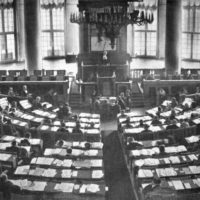
The meeting room of the State Duma 1906-1917

Solemn opening of the State Duma and the State Council. Winter Palace. April 27, 1906.
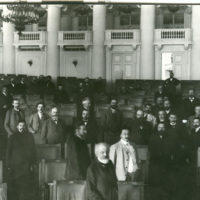
Deputies of the First State Duma at the first meeting of the First State Duma in the Tauride Palace. Opening of the First State Duma. April 27, 1906.
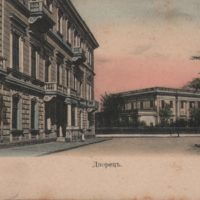
Odessa Palace. 1900-1914 - Russian postcard. Public domain image.
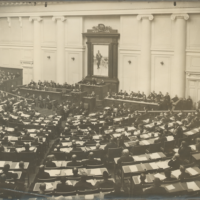
Meeting of the 4th State Duma December 5, 1912.

Belovezh Palace. The Tsar's Hunt 1894

Murom, Society of Banners at the Muromsky Cathedral. 1913
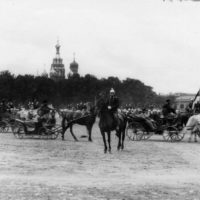
Solemn ceremony of meeting Prince of China Zaitao in St. Petersburg, Russia. 1910

The Arkhangelsk electoral assembly. Elections to the First State Duma. 1906
Meeting of the State Council at the Mariinsky Palace. 1908
Summary
Meeting of the State Council at the Mariinsky Palace. 1908
During 1906–1917, the status of the State Council was defined by the Russian Constitution of 1906. Its chairman was appointed by the Tsar. Half of its members were appointed by the Tsar from persons distinguished at civil and military service, and half by elections from each of the categories of society, separately. The State Council was the upper house of the parliament, while the State Duma of the Russian Empire was the lower house. The State Council ceased to exist after the February Revolution of 1917.
Заседание Государственного Совета в Мариинском дворце. 1908 г.
Государственный совет (также иногда сокращённо Госсовет) — высший законосовещательный орган Российской империи в 1810—1906 годах и верхняя палата Парламента Российской империи в 1906—1917 годах.
Vsesoslovnoe representation in was established by the Manifesto on the establishment of the State Duma and the law on the creation of the State Duma, published August 6, 1905. Nicholas II under the pressure of Premier S.Witthe writes: "Now it is time, following the good endeavors of them, to call elected people from the whole of the Russian land to a permanent and active participation in the drafting of laws, including for this purpose a special law-setting institution in the composition of higher state institutions, which is provided with the preliminary development and discussion of legislative proposals and consideration of the mural of state revenues and expenditures. " For the first time the Duma was convened in 1906 and existed for 12 years and 4 convocations (first, second, third, fourth State Duma). The number of Duma deputies varied from 480 to 525 people at different times. On April 23, 1906, Nicholas II approved a set of laws that the Duma could change only on the initiative of the Tsar himself. The executive power was subordinate only to the tsar. The First Duma lasted from April to July 1906. There was one session. Elections to the Duma were determined in the law on elections, issued in December 1905. According to him, four electoral curiae were established: landowners, city, peasants and workers. According to the workers' curia, only those proletarians who were employed in enterprises employing no less than 50 were allowed to vote. Elections were not universal (women, youth under 25, servicemen, and a number of national minorities were excluded), not equal (one elector was in the landowning curia for 2 thousand voters, in the urban - 4 thousand, in the rural - 30, for 90 thousand), not direct - two-stage, but for workers and peasants three - and four-degree. The largest fraction was the Cadets - 179 deputies. The Octobrists - 16 deputies, the Social Democrats - 18. From the so-called national minorities there were 63 representatives, non-partisans - 105. The fraction of the agrarian labor party of Russia, the Trudoviks, counted 97 deputies. Всесословное представительство в России было учреждено Манифестом об учреждении Государственной Думы и законом о создании Государственной Думы, изданными 6 августа 1905 года. Николай II под давлением премьера С.Ю.Витте пишет: "Ныне настало время, следуя благим начинаниям их, призвать выборных людей от всей земли Русской к постоянному и деятельному участию в составлении законов, включив для сего в состав высших государственных учреждений особое законосовещательное установление, коему предоставляется предварительная разработка и обсуждение законодательных предложений и рассмотрение росписи государственных доходов и расходов". В первый раз Дума была созвана в 1906 году и просуществовала 12 лет и 4 созыва (первая, вторая, третья, четвертая Государственные Думы). Число депутатов Думы в разное время колебалось от 480 до 525 человек. 23 апреля 1906 года Николай II утвердил свод законов, который Дума могла изменить только по инициативе самого царя. Исполнительная власть подчинялась только царю. Первая Дума просуществовала с апреля по июль 1906 года. Состоялась одна сессия. Выборы в Думу определялись в законе о выборах, изданном в декабре 1905 года. Согласно ему учреждались четыре избирательные курии: землевладельческая, городская, крестьянская и рабочая. По рабочей курии к выборам допускались лишь те пролетарии, которые были заняты на предприятиях с числом работающих не менее 50. Выборы были не всеобщими (исключались женщины, молодежь до 25 лет, военнослужащие, ряд национальных меньшинств), не равными (один выборщик приходился в землевладельческой курии на 2 тысячи избирателей, в городской - на 4 тысячи, в крестьянской - на 30, в рабочей - на 90 тысяч), не прямыми - двухстепенными, а для рабочих и крестьян трех - и четырехстепенными. Самой многочисленной фракцией были кадеты - 179 депутатов . Октябристы - 16 депутатов, социал-демократы - 18. От так называемых нацменьшинств было 63 представителя, беспартийных - 105. Фракция аграрной трудовой партии России, "трудовиков", насчитывала 97 депутатов.
- 15 Государственный Совет Image: PICRYL Public Domain Search}
- Государственный Совет в лицах
- Государственный Совет Российской Империи в лицах ...
- Meeting of the State Council at the Mariinsky Palace. 1908 ...
- Государственный Совет в лицах - LiveJournal
- Государственный Совет в лицах: humus — LiveJournal
- Duma - Дума | Romanov Empire - Империя Романовых collections
- humus | Государственный Совет в лицах
- Государственный совет Российской империи в лицах - LiveInternet
- Государственный Совет в лицах - humus
